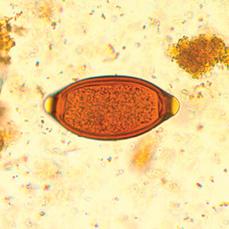Trichuriasis
John S. Schieffelin and Richard A. Oberhelman
Trichuriasis is caused by infection of the large intestine with Trichuris trichiura, the whip-worm. Whipworm infection is cosmopolitan, but it is far more common in warm, moist climates, where the distribution of Trichuris and Ascaris overlap.1,2 Approximately 604 million people are infected worldwide. Infection is generally acquired in childhood; whipworm ova often pollute the ground where children play. Transmission of infection occurs by ingesting embryonated eggs, which may contaminate hands or food, including fruits and vegetables, that were fertilized using human feces.3 The life-cycle is shown in eFig. 333.1  .
.
T trichiura is a distinctive nematode with a thin, whiplike anterior and a broader posterior portion. Males are 3.0 to 4.5 cm long, with a coiled posterior end; females are 3.5 to 5.0 cm long, with a blunt posterior end. The eggs are barrel-shaped, 50 μm by 22 μm, usually yellowish-brown with translucent polar plugs (Fig. 333-1). Adult worms live in the cecum with their anterior portions anchored in the mucosa. The appendix and the lower ileum may also be infected. The female lays 3000 to 10,000 eggs daily, which pass out in feces. An infective-stage larva develops within the egg after 3 weeks in warm, shady, moist soil. After ingestion, the larvae hatch in the duodenum and migrate to the cecum, where they develop into mature, egg-laying adults within 1 to 3 months.

Stay updated, free articles. Join our Telegram channel

Full access? Get Clinical Tree


